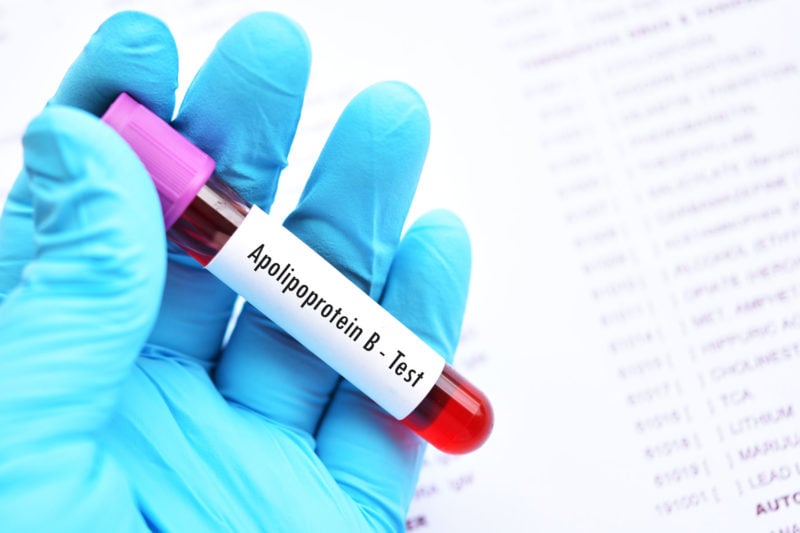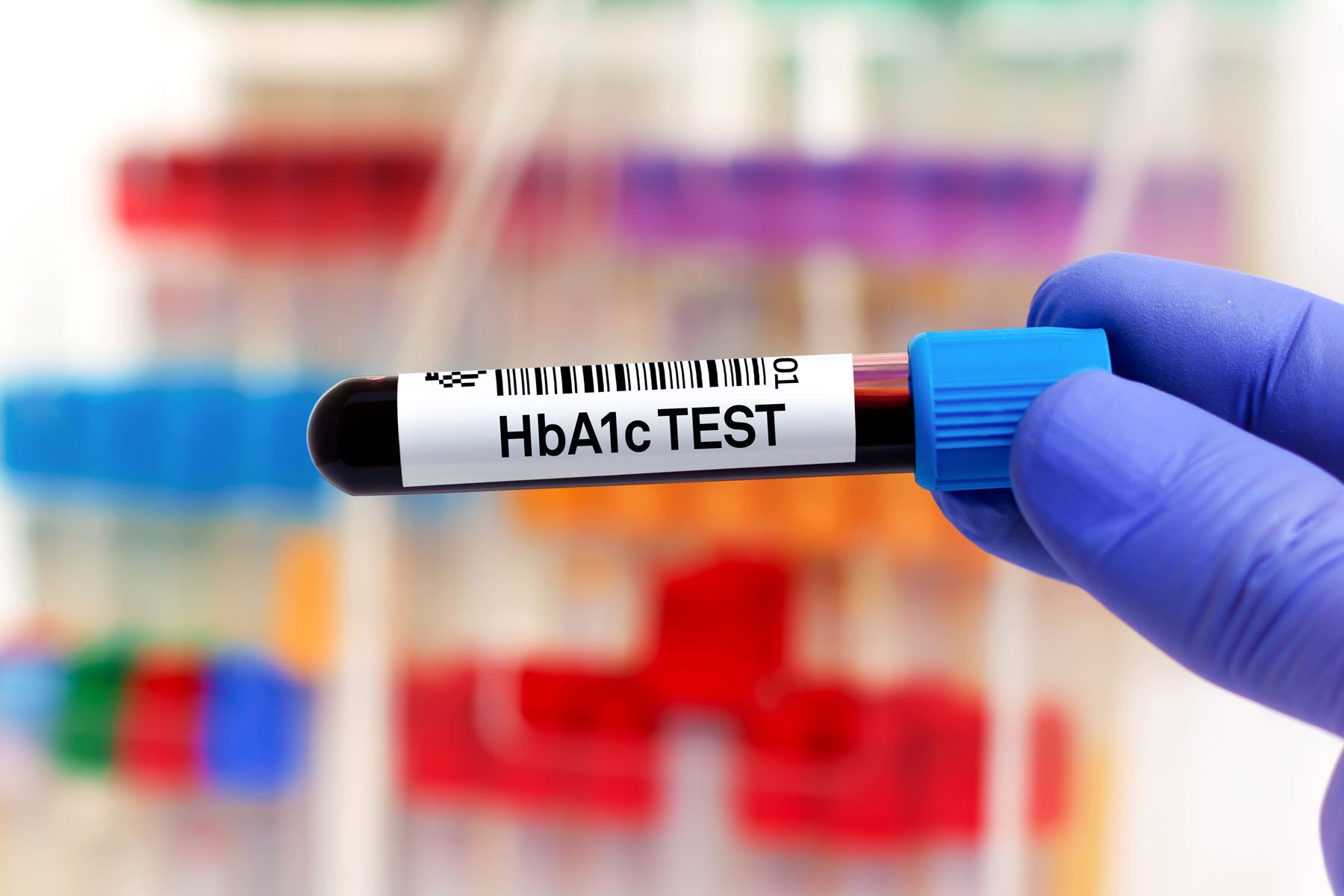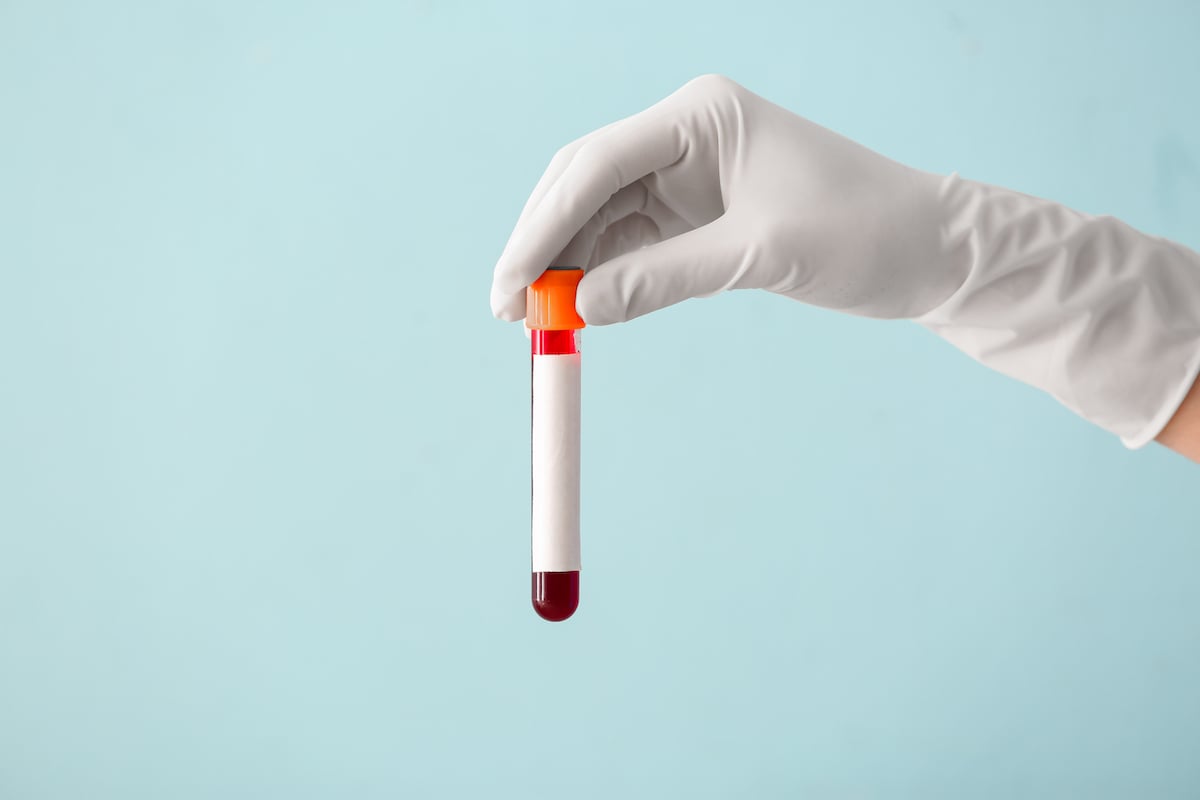What is the ApoB Test?
The ApoB test measures your body’s level of Apolipoprotein B-100 (also simply known as ApoB). ApoB is a protein that helps carry cholesterol and other important compounds through your bloodstream to the tissues that need them. Testing for this protein helps doctors quantify the number of potentially dangerous cholesterol-carrying particles in your body, thus giving insight into your risk of heart disease.
ApoB is one of several tests used to measure cholesterol levels, and its adoption by medical professionals has been slow (though Europe is slightly ahead). The reasons for this lag are contested. For instance, some authors (and doctors) cite the test’s added costs as an obstacle; others point out that ApoB testing is very inexpensive. Many clinicians still rely on traditional cholesterol tests to gauge heart health risk, including LDL cholesterol and triglyceride measurements. But ApoB testing provides important information that these other tests may miss.
What does ApoB Measure?
To understand how ApoB predicts cardiovascular risk, we first need to step back and understand cholesterol. Cholesterol is a waxy substance, a type of fat (lipid) that’s essential for human life. It’s used by cells as a structural material (to build cell membranes and insulate nerve cells) and as a building block for important hormones (e.g. cortisol, estrogen, and testosterone). Every cell can make its own cholesterol, but it’s produced in the largest quantities by the intestines (which absorb and repackage some cholesterol from dietary sources) and the liver. These organs then export cholesterol to other cells and tissues via the bloodstream. But this step presents the body with a challenge: Cholesterol is hydrophobic. It does not disperse easily in the blood but instead clumps together like oil in water. The solution is a particle called a lipoprotein—a molecule that encases cholesterol in a hydrophilic shell so that it can travel through the blood in small, discrete parcels.
There are many different types of lipoprotein particles that sequentially change into each other as triglycerides are offloaded. At the beginning of this chain is the Very Low-Density Lipoprotein (VLDL) molecule. VLDLs are formed when your liver bundles cholesterol along with triglycerides (another fatty substance that stores energy) into a large, protein-wrapped molecule. This molecule is “low-density” in the sense that it floats in blood—it is buoyant. The VLDL is then sent out into your bloodstream, where it circulates until it encounters a cell with an open receptor (typically a smooth muscle cell or fat cell). The VLDL then deposits its triglycerides into the cell, which can store them or use them for immediate energy.
Having lost some of its mass, the VLDL particle is now a smaller, less-buoyant molecule called an Intermediate Density Lipoprotein (IDL). These IDLs return to the liver, which removes about half of them from circulation. The other half is further stripped of triglycerides via a process called hydrolysis, which uses an enzyme (hepatic lipase) to break down the triglycerides into component parts. The IDLs have now become Low-Density Lipoproteins, or LDLs (commonly known as “bad cholesterol”). These are the smallest, densest lipoproteins yet, and they carry a very high concentration of cholesterol. LDL particles circulate in the bloodstream until they encounter a cell with an available LDL receptor, at which point they are absorbed by the cell (a process called endocytosis) and broken down into component parts. The cholesterol is then stored. When stored cholesterol passes a certain threshold, the cell slows its own production of cholesterol and of new LDL receptors. Over time, this can make it harder for LDL particles to deposit cholesterol, raising your circulating levels of LDL. Finally, there is a chemical variant of LDL called Lipoprotein(a) or Lp(a). The biological purpose of this particle remains unclear, but it may accelerate wound healing and tissue repair.
The four lipoproteins described above—VLDL, IDL, LDL, and Lp(a)—are all atherogenic. This means they can all cause serious cardiovascular disease by contributing to the build-up of plaque in the arterial wall. But LDL particles are by far the most abundant (representing 90% of disease-causing lipoproteins) and also the most atherogenic—particularly when they are small and dense. (LDL particle size varies significantly based on both environmental and genetic factors. More on this in the following section.)
The disease process can begin when an atherogenic lipoprotein breaches the walls of a coronary artery. This kicks off an inflammatory process, attracting a type of waste-clearing immune cell called a macrophage. If there is too much cholesterol for the macrophage to clear, the macrophage becomes a less mobile, cholesterol-heavy “foam cell.” Over time, these foam cells can build up in hard atherosclerotic plaques. They can also release inflammatory chemicals (like chemokines and cytokines), which attract even more macrophages. Eventually, these arterial plaques can narrow your blood vessels and deprive your major organs of blood. They can also suddenly rupture and cause blood clots, blocking the blood vessel completely. This is how heart attacks and strokes occur. Lp(a) seems to contribute to this process by accelerating inflammation.
Each of the four atherogenic lipoproteins contains a single ApoB protein, which wraps around the surface of the molecule and provides an essential part of the outer hydrophilic shell. This one-to-one ratio is important because it allows us to use ApoB as a surrogate marker. By tracking the number of ApoB-carrying molecules in your bloodstream, we can track the number of disease-promoting particles.
There is another type of lipoprotein that is not atherogenic: High-Density Lipoprotein (HDL). Higher HDL cholesterol levels have been linked to lower rates of cardiovascular disease (hence HDL’s nickname, the “good cholesterol”). Historically, researchers have argued that this effect was due to HDL’s role in so-called reverse cholesterol transport, in which HDL molecules enter the arteries and remove cholesterol before it adds to atherosclerotic plaque. It has also been suggested that HDL dampens inflammation and oxidation in the arteries, helping prevent plaque formation. Recent research, however, has cast some doubt on this theory: Studies that used medication to elevate HDL levels did not produce the expected cardiovascular benefits, leaving researchers still investigating its role in heart disease.
Even so, it is clear that HDL does not cause atherosclerotic heart disease. It also doesn’t carry an ApoB protein. This is convenient—it means an ApoB test only tracks atherogenic lipoproteins (VLDL, IDL, LDL, and Lp[a]) while ignoring neutral (or possibly beneficial) HDL particles.
Why Might You Get ApoB Tested?
ApoB can give you critical information about your long-term heart health. This may be especially important for people with familial hypercholesterolemia, as well as people with a current heart disease diagnosis who are monitoring their condition. In both the US and Europe, professional medical society guidelines recommend ApoB testing as a way to gauge risk and guide treatment decisions—particularly in people with elevated triglyceride levels (itself a risk factor for heart disease). And while it is not yet recommended by any professional guidelines, some clinicians recommend the ApoB test to screen for heart disease risk when no other risk factors are present.
The evidence strongly supports a link between ApoB and heart disease. For instance, a 2011 meta-analysis of 12 studies (covering 233,455 people and 22,950 dangerous heart events) found that ApoB levels are a powerful predictor of heart disease. Similarly, a 2021 UK study of around 400,000 people found that higher levels of ApoB lower lifespan while increasing the risk of heart disease and stroke.
ApoB testing is sometimes used alongside other cholesterol tests but may yield pivotal information that these other tests cannot. For example, the LDL-C test (which is the standard, first-line test for atherogenic risk) measures the total amount of cholesterol contained in LDL particles in your body. This measurement is typically calculated indirectly (via either the Friedewald equation or the Martin-Hopkins method) from HDL, triglyceride, and total cholesterol levels, which are easier to measure directly than LDL-C. Occasionally, LDL-C is measured directly using proprietary chemical tests (which have been criticized as unreliable and unstandardized). In any case, whether measured directly or indirectly, LDL-C testing (unlike ApoB testing) does not measure VLDL, which we know is atherogenic.
More importantly, LDL-C tests measure the total concentration of cholesterol, which can be misleading. Two people with the same cholesterol mass might have a very different number of cholesterol particles. This is possible because some LDL particles are large (i.e. they carry more cholesterol), and some are small (i.e. they carry less cholesterol). And in the last decade, it has become clear that a person with many small LDL particles would be at an increased risk than someone with few large LDL particles. In other words, research has shown that the number of LDL particles (LDL-P), rather than total cholesterol mass (LDL-C), correlates with heart disease risk. This is why ApoB testing gives more accurate risk predictions than LDL-C testing: It tracks LDL particle number. This superior accuracy was acknowledged by the American College of Cardiology and the American Heart Association in their 2018 clinical guidelines.
Another blood test that is sometimes used to measure heart disease risk is the non-high-density lipoprotein cholesterol test. Non-HDL-C is calculated by measuring your total blood cholesterol mass, then subtracting from it the mass of all cholesterol contained in HDL particles. This tells us the total mass of all cholesterol contained in your VLDL, IDL, and LDL particles. In principle, this may give the test a slight advantage over LDL-C testing, which neglects VLDL. Notice, however, that non-HDL-C still tells us nothing about particle count. Two people could have the same non-HDL-C score and radically different LDL-P numbers. (Research shows that this sort of variation is common: LDL particle sizes vary widely across the population.) We should therefore expect ApoB to more accurately predict heart disease risk than non-HDL-C. And this is exactly what the research shows: non-HDL-C is more accurate than LDL-C but less accurate than ApoB. In a small number of studies, non-HDL-C testing performs as well as ApoB testing—but never better (and in many studies, worse). Many doctors and researchers still prefer non-HDL-C to ApoB testing, as non-HDL-C can be easily calculated from the standard lipid panel used in primary care. ApoB, on the other hand, requires doctors to learn about and deploy an entirely new test. So while ApoB has proven to be a technically superior metric, it is also sometimes seen as a more ambitious (and perhaps less realistic) target from a public health perspective.
ApoB testing is thus a very reliable way to measure your heart disease risk. You can use it in combination with other tests (such as the LDL-C or non-HDL-C tests) for a more complete picture of your heart health.
ApoB may also reveal important information about your metabolic health (which is closely related to heart health). The Women’s Health Study followed 17,527 women over 8 years and found that higher levels of ApoB were linked to a greater risk of hypertension. This effect has been observed even when controlling for other risk factors. For instance, a 2020 study of 233 Japanese Americans found that people with high ApoB were more likely to develop hypertension regardless of insulin sensitivity and abdominal fat (two factors that correlate with metabolic health). Another study of 2348 people found that people with high ApoB were more likely to develop metabolic syndrome and dyslipidemia, even when controlling for waist circumference and inflammation. The above-mentioned study of nearly 500,000 people found that high ApoB increases the risk of diabetes. And finally, a 2005 study of 7427 Korean people found that high ApoB was linked to insulin resistance, even in people with normal blood sugar levels.
While ApoB testing hasn’t been recommended by medical societies as a tool to diagnose or treat metabolic illnesses (such as hypertension and diabetes), you may find that it contributes to your understanding of your holistic health. Working closely with your healthcare provider, the ApoB test can help you evaluate your risk of disease in the future, monitor illness today, and guide treatment decisions (such as the use of cholesterol-lowering medication like a statin).
How Do You Get ApoB Tested?
The ApoB test is not typically included as part of a standard lipid panel, so you may need to request it from your doctor. However, doctors aren’t always familiar with ApoB testing or well-informed about it. Current medical training and professional guidelines still regard ApoB as an ancillary test to be used when standard cholesterol tests (i.e. LDL-C, HDL-C, and triglycerides) indicate a problem. So if you’re currently healthy and requesting an ApoB test for heart health screening purposes, your provider may not understand why. In other words, you might need to make a case for ApoB testing. It can be helpful to have prepared resources available to share for this purpose.
You can also order an ApoB test directly from a commercial laboratory like Quest Diagnostics or Labcorp. The test itself requires a simple blood draw which can be performed by a nurse or laboratory technician. You may or may not need to fast beforehand, depending on the laboratory and whether other tests are being performed. If your ApoB test is not covered by insurance, it will likely cost $60-$70.
Related article:
What is the Optimal Range for ApoB?
Different groups have reached different conclusions about the optimal range of ApoB. Generally speaking, lower ApoB is considered better—but the safe cutoff point is still being discussed.
In the clinical guidelines published by the American College of Cardiology and the American Heart Association, an ApoB of 130 mg/dL or above is considered a “risk-enhancing factor” for atherosclerosis. Other researchers have set 120 mg/dL as the threshold at which “normal” ApoB becomes elevated.
Some groups set more aggressive ApoB targets for people who are at special risk of coronary heart disease. For instance, a 2008 report from the American Diabetes Association and the American College of Cardiology Foundation recommends an ApoB target of less than 90 mg/dL for people who are at risk of heart disease (e.g. people with diabetes). For people at even higher risk (e.g. people who currently have heart disease), it suggests an even lower target of less than 80 mg/dL. Medscape, a clinical resource used by healthcare providers, makes similar recommendations: 130 mg/dL as a safe ceiling for low-risk patients, 110 mg/dL for moderate-risk patients, and 90 mg/dL for high-risk patients. This is fairly aligned with a statement by the American Association for Clinical Chemistry, which recommends an ApoB ceiling of 100 mg/dL in moderate-risk patients and 80 mg/dL in high-risk patients.
It’s important to note, however, that the field has not reached a clear consensus around any of these numbers. Most groups have generated their recommendations by taking established LDL-C treatment goals and calculating an equivalent ApoB level based on population percentiles. Currently, it’s unclear how reliable this procedure is, especially for people in the highest-risk groups. Using the most aggressive LDL-C targets (such as those of the National Cholesterol Education Program) can result in ApoB targets as low as 54 mg/dL—a number that some researchers have argued is unreasonably low and could mislead patients and clinicians. And while lower ApoB (like LDL-C) is generally considered better, extremely low levels could be indicative of an underlying illness such as overactive thyroid or chronic liver disease.
For this reason, it’s important to work with your healthcare provider when interpreting your ApoB levels. ApoB testing can reveal important information about your cardiovascular and metabolic wellness, but it should always be synthesized with other holistic health data under professional guidance.









